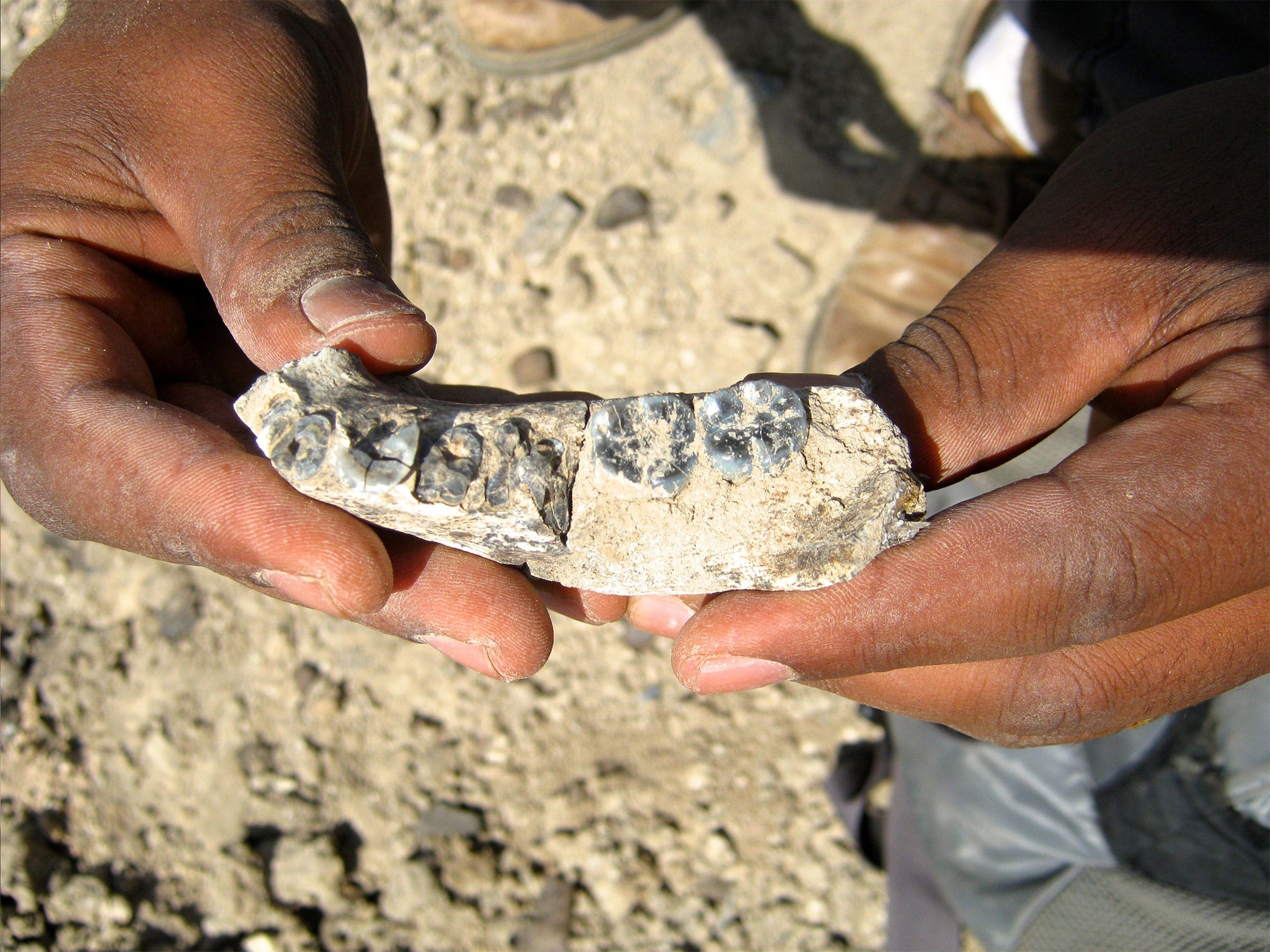African jawbone discovery pushes birth of humanity back by 400,000 years
Incomplete mandible with teeth was found by Ethiopian graduate student Chalachew Seyoum

Your support helps us to tell the story
From reproductive rights to climate change to Big Tech, The Independent is on the ground when the story is developing. Whether it's investigating the financials of Elon Musk's pro-Trump PAC or producing our latest documentary, 'The A Word', which shines a light on the American women fighting for reproductive rights, we know how important it is to parse out the facts from the messaging.
At such a critical moment in US history, we need reporters on the ground. Your donation allows us to keep sending journalists to speak to both sides of the story.
The Independent is trusted by Americans across the entire political spectrum. And unlike many other quality news outlets, we choose not to lock Americans out of our reporting and analysis with paywalls. We believe quality journalism should be available to everyone, paid for by those who can afford it.
Your support makes all the difference.A fossilised jawbone found poking out of the ground in Ethiopia has set the story of human origins back nearly half a million years to a time when early man shared the vast grassland plains of eastern Africa with a rich variety of prehistoric animals.
Scientists have confirmed that the jawbone belongs to the Homo genus and, at 1.8 million years old, is more than 400,000 years older than the oldest previous fossil of the same group of early humans who eventually gave rise to our own species, Homo sapiens.
The incomplete mandible with teeth was found by graduate student Chalachew Seyoum of the Authority for Research and Conservation of Cultural Heritage in Addis Ababa, who made the discovery while surveying a hill in the Ledi-Geraru area of the Afar region of Ethiopia, where many early human fossils have been unearthed.
“After I had climbed up to the plateau, I saw a premolar coming out of the sediment and it attracted my eye,” Mr Seyoum said, explaining that the jawbone had already become partially exposed by the weathering of the surrounding rock.
Although scientists are not yet sure which species the jawbone’s owner belongs to, they are confident it can be included in the “human” lineage of Homo, which is characterised by an upright, bipedal posture, sophisticated tool-making abilities and a relatively large braincase.
“In spite of a lot of searching, fossils on the Homo lineage older than two million years ago are very rare. To have a glimpse of the very earliest phase of our lineage’s evolution is particularly exciting,” said Brian Villmoare of the University of Nevada and lead author of the study published in the journal Science.
The previous oldest Homo specimen was an upper jawbone from Ethiopia dating to about 2.3 million years ago and was classified as the earliest known member of Homo habilis, a species thought to have given rise to the later Homo erectus, which then evolved into Homo sapiens.
Homo habilis was first described by the paleoanthropologist Louis Leakey in 1964 who based the description on fossilised remains – a lower jawbone, parts of a braincase and hand bones – unearthed in Olduvai Gorge in Tanzania, dated to 1.8 million years old.
However, a new study of this partial skull with CT X-rays, published in the journal Nature, has now revealed that its jawbone was in fact more primitive than the much older H. habilis specimen dating to 2.3 million years ago.
This suggests there must have been an even older common ancestor of both H. habilis specimens, said Fred Spoor of University College London and the Max Planck Institute for Evolutionary Anthropology in Leipzig, who believes the answer now lies with the new jawbone discovery in Ethiopia.
“We were in contact with the other group working in Ethiopia and they said they may have found what we are looking for in the shape of this specimen dating to 2.8 million years ago,” Dr Spoor told The Independent.
“It’s certainly the case that this new lower jawbone is a good bridge between the primitive Australopithecus afarensis and Homo habilis. It’s on the human lineage, the lineage that leads to us,” Dr Spoor said.
One of the unresolved questions is what environmental conditions led to the evolution of Homo. Some scientists have suggested that climate change and drought could have sparked the development of the human adaptations needed to survive on savannah grasslands populated by prehistoric antelope and elephants.
“We can see the 2.9 million-year-old aridity signal in the Ledi-Geraru faunal community. But it’s still too soon to say that this means climate change is responsible for the origin of Homo,” said Kay Reede of Arizona State University.
“We need a larger sample of hominid fossils and that’s why we continue to come to the Ledi-Geraru area to search,” Dr Reede said.
Join our commenting forum
Join thought-provoking conversations, follow other Independent readers and see their replies
Comments